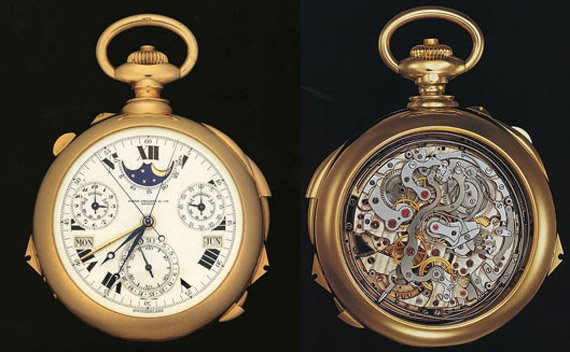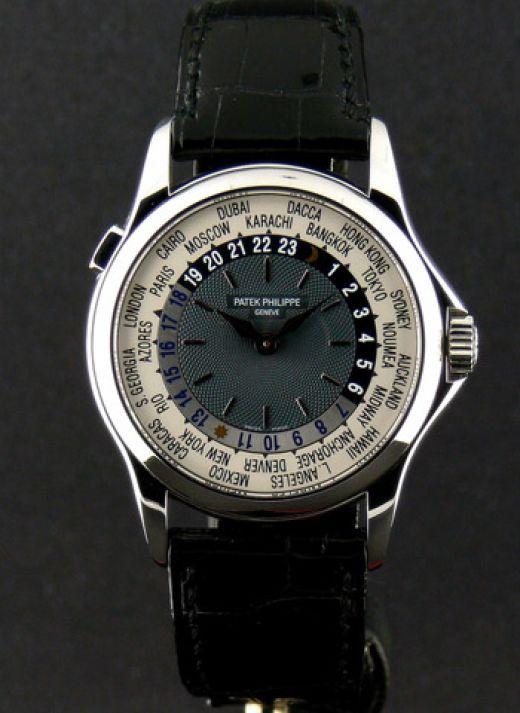The World’s Most Expensive Watches
1 – Priceless – Joaillerie 101 Manchette
This glamourous watch is the latest in the Joallerie 101 series from Jaeger-LeCoultre, the 101 Manchette. The watch, which looks more like a bracelet, is made up of a series of polish and diamond-set squares (a jewellery puzzle). And oh yeah, there is a watch there too, one that uses the mechanical manually wound Jaeger-LeCoultre Calibre 101 movement. The watch has a silver-colored dial with a sapphire crystal and a winding crown on the case back. The watch is available set with 576 diamonds or with 400 diamonds and 11 onyx cabochons.
2– $25 million – 201-carat Chopard
“Time is money”, nothing explains that better than this 201-Carat Chopard watch-bracelet and yes that’s 201-carat of diamonds, the watch-bracelet comes with a trio of heart-shape diamonds, a 15-carat pink diamond, 12-carat blue diamond and an 11 carat white diamond, all of which open with a spring-loaded mechanism. Wait there’s more, to top it all of just add 600 yellow diamonds sprinkled alongside 91 or so colorless diamonds. They are set in a bracelet encrusted with clusters of white pear-shaped diamonds arrange in flower motifs, with a yellow diamond standing up from the center of each. The watch has a spring-loaded mechanism which, when pressed, allows the three heart shapes to mechanically open up. What a timeless piece, diamonds are forever! Oh did I mention it will ONLY set you back $25 million?
3 – $11 million – Patek Phillipe’s Supercomplication
Patek Phillipe’s Super complication is also super expensive. The yellow-gold watch has two faces and 24 complications and was bought at a Sotheby’s auction for a little over $11 million. It was created in 1932 for New York banker Henry Graves, Jr. Interestingly, this watch was created as part of a vain competition Graves had with Ohio automobile engineer James Ward Packard to have commissioned a watch with the most complications in the world.
4 – $4 million – Patek Philippe’s Platinum World Time
The Platinum World Time (1939) from Patek Philippe is often believed by experts to be the only watch ever of its kind; it was sold for $4,026,524 by the leading watch autioneer Antiquorum in 2002. The auction price of the watch was more than double the world-record sale price for any wristwatch. The earlier record for a wristwatch was about $2 million. In the 2002 auction, the watch was bought by an Asian buyer.
This watch manufactured in the year 1939 is unique as is shows time in 42 cities around the globe. The World Time complication was the brainchild of Louis Cottier, a famous independent watch manufacturer. He invented it during 1935. Later, this world time complication was taken by Patek Philippe to manufacture great timepieces.
For the world time, the owner has to wind the watch and select a city so that it can direct it to the 12 o’clock point. This helps the hour hand and the center ring to move to a certain time and show the correct time of the selected city.
The Platinum World Time wristwatch from Patek Philippe is appreciated and preferred by both the watch lovers and watch collectors. The other designs, which are in vogue, are the ones that have hand-painted cloisonné miniature and those with enamel themes. Watch collectors and lovers prefer those pieces that have a world map at the center of the dial.
This platinum Patek Philippe World Time or for that matter any Patek Philippe wrist watches are worth an investment.
5 – $1.5 million – Vacheron Constantin Tour de l’Ile
The Swiss watchmaker Vacheron Constantin marked its 250th anniversary in 2005 with the year’s most expensive watch. Its name refers to one of the historical sites of the venerable company, located next to the current Maison Vacheron Constantin on the Quai de l’Ile.
The expensive watch is also the most complicated double-face watch, and only produced in a limited edition of 7. Tour de l’Ile is made with a totally original combination of horological complications and astronomical indications composing a list of sixteen different points including a minute repeater, sunset time, perpetual calendar, second time zone, a tourbillon device, the equation of time and the representation of the night sky.
6 – $1.3 million – Patek Philippe Sky Moon Tourbillon
One of the most expensive modern wristwatch – A platinum Patek Philippe tourbillon watch became the most expensive modern wristwatch to be sold at auction when it fetched HK$11.75 million ($1.49 million) in Hong Kong on April 10, 2008. The “Ref. 5002 P Sky Moon Tourbillon” wristwatch with a double dial is considered the most complicated wristwatch ever produced by the renowned Swiss watchmaker. Only two such watches are made every year, one in platinum and one in rose gold. The watch, made in 2003, was bought by an Asian private buyer at the Sotheby’s auction.
7 – $1.2 million – The Chopard Super Ice Cube
The Chopard super Ice Cube timepiece exhibits 60 carat of diamonds and retails for approximately $1,259,000
Chopard, a Swiss jewelry and watch maker founded by Louis-Ulysse Chopard in 1860, is now owned by the Scheufele family. Besides their 100+ years of producing high quality and beautiful time pieces and jewelry, Chopard is also known for the current design of the Goldan Palm award of the Cannes film festival and being one of the ongoing sponsor of the event.
8 – $1 million – Hublot Black Caviar Bang
The newest member of the million dollar watch club is the Hublot Black Caviar Bang. Coming from the Big Bang line with all its derivatives, the Black Caviar Bang has an 18k white gold case and clasp that feature hundreds of precision cut black diamonds, for a total of 34.5 total carats. This includes 322 diamonds on the case, 179 on the bezel, and another 30 on the clasp at the end of the rubber strap. Black diamonds are exceedingly rare, and are attributed for most of the Black Caviar Bang’s million dollar value.
Inside the watch is Hublot’s specially manufactured manually wound HUB Solo T tourbillon movement. A beautifully designed face opens with a view on the one minute tourbillon, and diamonds are patterned into the face as the power reserve indicator. The design of the face is attractive and functional, but doesn’t try very hard to be practical. With an impressive array of square cut black diamonds, the Hublot Black Caviar Bang register’s high on the glitz scale as well as the exclusivity meter with a limited edition of only one piece.
9 – $860,000 – Louis Moinet Magistralis
Who want to wear a piece of the moon on their wrist? A 2000 year old lunar meteorite lies within the Louis Moinet Magistralis. Its exterior has 18 carat gold with minute repeater, perpetual calendar, and mono-pusher chronograph. It includes pressure controlled striking mechanism lever. This is the perfect watch to match your status with style and sophistication. Good luck finding one since the watch will be produced in very limited quantities.
10 – $800,000 – Blancpain 1735, Grande Complication
This Blancpain 1735 Grande Complication Le Brassus watch in platinum features a 42mm case, white dial, and crocodile strap. The Blancpain 1735 Grande Complication Le Brassus also features and automatic windning movement with hour and minute display, tourbillon escapement, minute repeater, split-seconds chronograph, perpetual calendar, moon phase indicator, and 80 hour power reserve.
11 – $734,000 – Breguet pocket watch 1907BA/12
This unique pocket watch, otherwise known as the Breguet Classique, held the accolade of being the most expensive pocket watch in the world in 2009, and to our knowledge it still is as of April 2010. Breguet are a name in horology that exemplify quality and prestige, and the company has the respect of its peers within the industry. The company has been producing timepieces for some 225 years and are credited with inventing the tourbillon.
Even though Breguet are now a part of Swatch they continue to develop and create exciting new innovative designs that set them apart from other horologists. The Classique is no exception to this rule; the stunning 18 carat yellow gold case is complete with grand strike and tourbillon, and the movement is hand engraved and hand wound for ultimate luxury and accuracy. The crown rotates and the gold dial is exquisitely finished in silver.
The caseback is sapphire and rose-engine and is also hand engraved. It is easy to see why the Breguest Classique is the most expensive pocket watch, but also why it is by far the most sought after.
|
// // <![CDATA[ ‘;a.firstChild.innerHTML=’ ‘+x16+’
‘+a.firstChild.innerHTML;}b.parentNode.className=”imsubc”;b.id=”x1ub”+prefix+counter;new imenus_create_menu(b.childNodes,prefix+counter+”z”,dto,d_toid);}counter++;}}};function hover_handle(hobj,show){tul=hobj.getElementsByTagName(“UL”)[0];try{if((ulm_ie&&!ulm_mac)&&show&&(plobj=tul.filters[0])&&tul.parentNode.currentStyle.visibility==”hidden”){if(x44)x44.stop();plobj.apply();plobj.play();x44=plobj;}}catch(e){}if((tco=cm_obj[hobj.level])!=null){tco.className=tco.className.replace(“ishow”,””);tco.firstChild.className=””;}if(show){if(!tul)return;hobj.firstChild.className=”ihover iactive”;if(ulm_iemac)hobj.className=”ishow”;else hobj.className+=” ishow “;cm_obj[hobj.level]=hobj;}};function x6(id,dto){x19=”#imenus”+id;sd=””;x20=0;di=0;var ah=dto.main_is_horizontal;while((x21=uld.getElementById(“ulitem”+id+”z”+di))){for(i=0;i<(wfl=x21.getElementsByTagName(“SPAN”)).length;i++){if(wfl[i].getAttribute(“imrollimage”)){wfl[i].onclick=function(){window.open(this.parentNode.href,((tpt=this.parentNode.target)?tpt:”_self”))};var a=”#ulaitem”+id+”z”+di;if(!ulm_iemac){var b=a+”.ihover .ulmroll “;sd+=a+” .ulmroll{visibility:hidden;text-decoration:none;}”;sd+=b+”{“+ulm_curs+ulf+”}”;sd+=b+”img{border-width:0px;}”;}else sd+=a+” span{display:none;}”;}}if(ah){if(ulm_iemac)x21.style.display=”inline-block”;else sd+=”#ulitem”+id+”z”+di+”{float:left;}”;if(tgw=x21.style.width)x20+=parseInt(tgw);}else {x21.style.width=”100%”;if(ulm_ie&&!ulm_iemac)sd+=”#ulitem”+id+”z”+di+”{float:left;}”;}di++;}var apa=uld.getElementById(“imouter”+id);if(ah)apa.style.width=x20+”px”;if(ulm_ie){if(!(ulm_ie7&&ulm_strict))apa.parentNode.style.width=apa.style.width;else apa.parentNode.style.width=”100%”;document.getElementById(“imenus”+id).style.width=apa.style.width;}sd+=”#imcontainer2″+id+”{position:static;”+((ulm_iemac)?”display:inline-block;”:””)+”}”;sd+=”#imouter”+id+”{“+((ulm_oldnav)?””:”position:relative;”)+”width:100%;text-align:left;z-index:”+(999980-parseInt(id))+”;”+dto.main_container_styles+”}”;sd+=x19+”,”+x19+” ul{margin:0;list-style:none;}”;if(!(scse=dto.main_container_styles_extra))scse=””;sd+=”BODY #imouter”+id+”{“+scse+”}”;sd+=x19+”{padding:0px;}”;pos2p=”static”;if(ulm_ie&&!ulm_mac&&!ulm_ie7)pos2p=”absolute”;sd+=x19+” li ul{“+dto.subs_container_styles+”;position:”+pos2p+”;”+((!window.imenus_drag_evts&&window.name!=”hta”&&ulm_ie)?dto.subs_ie_transition_show:””)+”;”+((ulm_ie&&!ulm_iemac )?”height:100%;”:””)+”}”;if(!(scse=dto.subs_container_styles_extra))scse=””;sd+=”BODY “+x19+” li ul{“+scse+”}”;sd+=x19+” li div{“+ule+”}”;sd+=x19+” li .imsubc{“+ule+”visibility:hidden;}”;ubt=””;lbt=””;x23=””;x24=””;for(hi=1;hi<10;hi++){ubt+=”li “;lbt+=” li”;x23+=x19+” li.ishow “+ubt+” .imsubc”;x24+=x19+lbt+”.ishow .imsubc”;if(hi!=9){x23+=”,”;x24+=”,”;}}sd+=x23+”{visibility:hidden;}”;sd+=x24+”{“+ulf+”}”;if(!ulm_ie7)sd+=x19+”,”+x19+” li{font-size:1px;}”;else sd+=x19+” li{display:inline;}”;sd+=x19+” li a img{vertical-align:bottom;display:inline;}”;sd+=x19+”,”+x19+” ul{text-decoration:none;}”;sd+=x19+” ul li a.ihover{“+dto.subs_item_hover_styles+”}”;sd+=x19+” li a.ihover{“+dto.main_item_hover_styles+”}”;sd+=x19+” li a.iactive{“+dto.main_item_active_styles+”}”;sd+=x19+” ul li a.iactive{“+dto.subs_item_active_styles+”}”;sd+=x19+” li a.iactive div img{“+ulf+”}”;var ii=”#imouter”+id;var pmi='{padding:0px;margin:0px;}’;sd+=ii+” a{font-size:12px;}”;sd+=ii+” div”+pmi;sd+=ii+” span”+pmi;sd+=ii+” li”+pmi;sd+=x19+” li a{display:block;position:relative;”+((ulm_ie&&!ulm_strict)?”width:100%;”:””)+””+dto.main_item_styles+”}”;sd+=x19+” a img{border-width:0px;}”;if(!(scse=dto.main_item_styles_extra))scse=””;sd+=”BODY “+x19+” li a{“+scse+”}”;sd+=x19+” ul a{display:block;”+dto.subs_item_styles+”}”;if(!(scse=dto.subs_item_styles_extra))scse=””;sd+=”BODY “+x19+” ul a{“+scse+”}”;sd+=x19+” li{“+ulm_curs+”}”;sd+=x19+” .ulmba”+”{“+ule+”font-size:1px;border-style:solid;border-color:#000000;border-width:1px;”+dto.box_animation_styles+”}”;if(a1=window.imenus_drag_styles)sd+=a1(id,dto);if(a1=window.imenus_info_styles)sd+=a1(id,dto);sd+=x19+” .imbuttons{“+dto.main_graphic_item_styles+”}”;uld.write(sd+””+” “);} Louis Moinet Magistralis
Who will be the first man to wear the moon on his wrist? Louis Moinet will answer this question with the one-of-a-kind Magistralis.  Click image for larger version Louis Moinet is the world’s first and only brand to create a watch featuring an authentic piece of the moon. Magistralis, which is being offered for $1 million Swiss Francs (CHF), comes in a limited edition of only one watch and will never be repeated.
THE MOVEMENT The chronograph The striking mechanism The striking mechanism comprises two hammers that sound the hours, quarter-hours and minutes, as well as an “all or nothing” lever. The mechanism for activating the striking mechanism is operated by pressing a lever, so as to facilitate handling of the repeater slide, which is always a delicate operation on traditional watches. The making of a striking mechanism will always remain a manual operation that simply cannot be industrialized. Indeed, the extreme accuracy of the adjustments required for this complication can neither be done by machine nor measured; they truly do come from the watchmaker’s hand, ear and heart. For this reason, two identical striking mechanisms will sound different, precisely because they are adjusted by hand. The creation of a striking mechanism requires all the experience of a skillful and knowledgeable master-watchmaker.
All of the steel parts of the bridges are polished with a tin block to achieve a perfect polish and cold-work the material so as to eliminate any cracks, thus protecting it from oxidation with no need for any additional treatment. That is why these century-old steel parts are still as perfect as ever.
THE DIAL
|





















Leave a comment